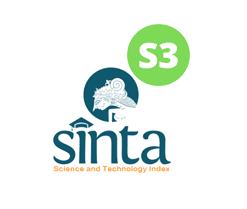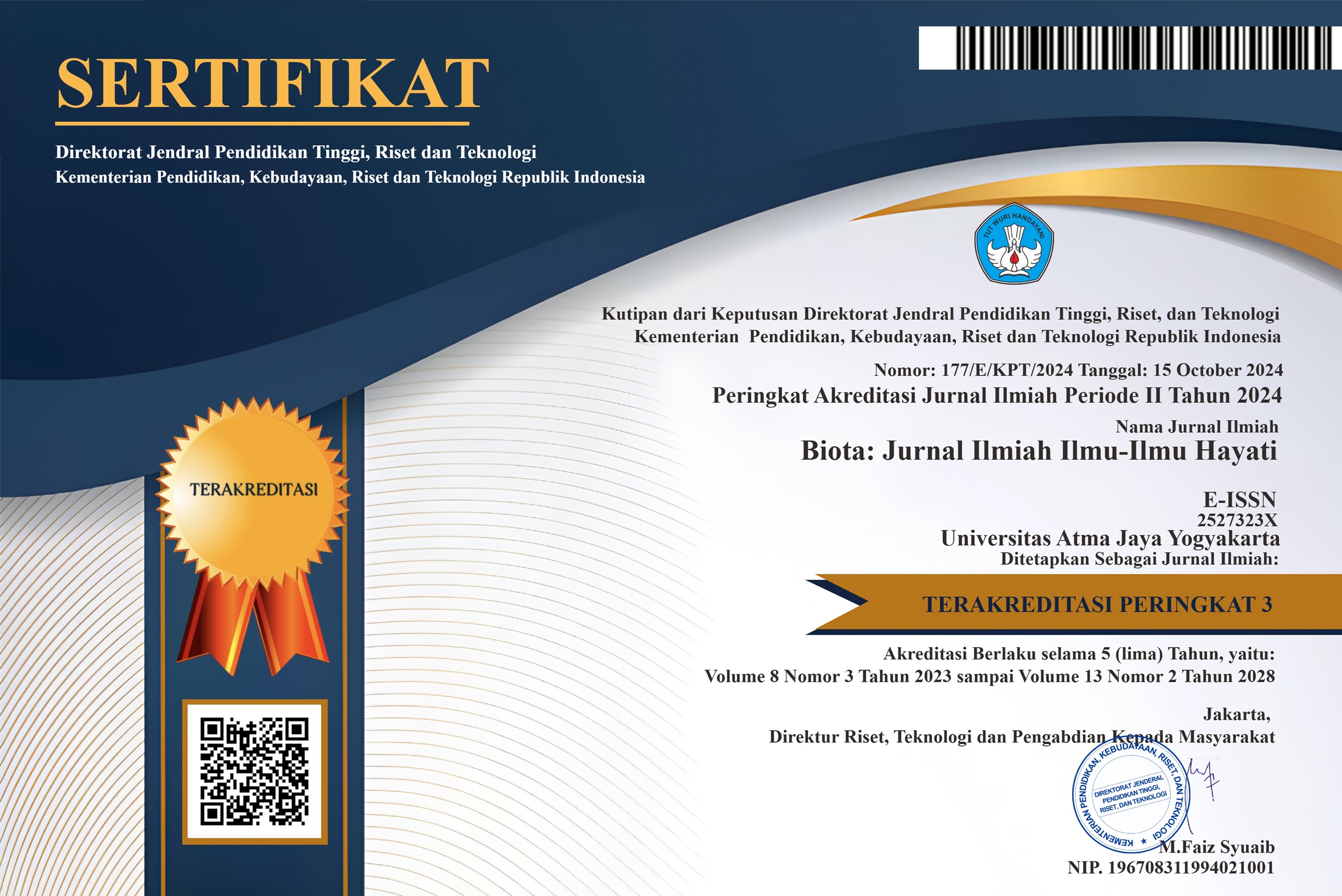Optimasi Metode Ekstraksi DNA pada Melon (Cucumis melo L.) Berdasarkan Suhu, Lama Inkubasi, dan Kondisi Daun
DOI:
https://doi.org/10.24002/biota.v5i2.4096Keywords:
DNA extraction, DNA isolation, melon DNA, DNA incubation, plant DNA samples, Ekstrasksi DNA, Isolasi DNA, DNA Melon, inkubasi DNA, Sampel DNA TanamanAbstract
Melon is a fruit commodity that has high economic value and is in demand by the community, so it has the potential to be developed. Therefore it is necessary to study various sciences, one of which is the molecular approach. DNA is an essential element in molecular research. The right extraction technique will determine the quality and quantity of DNA produced. The temperature and incubation time applied in the DNA extraction technique, as well as the quality of the leaves as a source of plant DNA, are among the determining factors for the quality and quantity of extracted DNA, so it is necessary to carry out an assessment and optimization. This study aims to assess the optimal temperature and incubation time in extracting DNA from material (melon leaves) under different conditions. Research activities include planting melon seeds, collecting leaf samples, DNA extraction and quantitative DNA testing. The results showed that the concentration and purity of DNA extracted from cold leaves was higher than that from fresh leaves. The highest DNA concentration was obtained from the 65 ° C incubation treatment for 20 minutes, namely 2707.6 ng / μl, and the highest DNA purity was obtained from the 70 ° C incubation treatment for 10 minutes, namely 1.94 from leaf material that had been cooled overnight at a temperature of -20 ° C .
References
Aras, S., A. Duran & G. Yenilmez. 2003. Isolation of DNA for RAPD Nalysis From Dry leaf Material of some Hesperis L. specimens. Plant Molecular Biology Reporter. 21: 461a- 461f
Direktorat Jenderal Hortikultura. 2015. Indonesia Kaya Berbagai Melon Unggulan. http://hortikultura.pertanian.go.id/?p=547. Diakses 13 Maret 2020
Ferniah, R. S. & Pujiyanto, S. 2013. Optimasi Isolasi DNA Cabai (Capsicum annuum L.) Berdasar Perbedaan Kualitas dan Kuantitas Daun serta Teknik Penggerusan. BIOMA, Vol.156, No. 1, Hal. 14-19
Garcia J, Oliver M, Paniagua HG & de Vicente MC, 2000. Comparing AFLP, RAPD and RFLP markers for Measuring Genetic Diversity in Melon. Theor Appl Genet. vol 1 (101): 860-864
Huda, I. N. & daryono, B. S. 2013. Analisis Variasi Genetik Melon (Cucumis melo L.) Kultivar Gama Melon Basket Dengan Metode Random Amplified Polymorphic DNA. Biogenesis: Jurnal Ilmiah Biologi, Vol 1, No. 1, hal 41-50
Langga, I. F., Restu, M. & Kuswinanti T. 2012. Optimalisasi Suhu dan Lama Inkubasi dalam Ekstraksi DNA Tanaman Bitti (Vitex cofassus Reinw) serta Analisis Keragaman Genetik Dengan Teknik RAPD-PCR. J. Sains & Teknologi, Vol.12 No.3 : 265 – 276
Ling, M. and L. Feldman. 2010. A rapid TRIzol-based two-step method for DNA-free RNA extraction from Arabidopsis siliques and dry seeds. Biotechnol Journal. 5 (2): 183-186.
Muladno. (2002). Seputar Teknologi Rekayasa Genetika. Bogor: Pustaka Wirausaha Muda.
Nicholl, D. S. T. 1993. An Introduction to Genetic Engineering. Department of Biological Science, University of Praisly.
Restu, M., Mukrimin, &Gusmiaty. 2012. Optimalisasi Teknik Ekstraksi dan Isolasi DNA Tanaman Suren (Toona Sureni Merr.) untuk Analisis Keragaman Genetik berdasarkan Random Amplified Polymorphic DNA (RAPD). Jurnal Natur Indonesia 14(2): 138-142
Sambrook, J., E. F., Fritsch, and T. Maniatis. 1989. Molecular Cloning: A Laboratory Manual. 3rd Edition. Cold Spring Harbor Laboratory Press. Cold Spring Harbor, N.Y. 87 p.
Subandiyah, S. 2006. Polymerase Chain Reaction untuk Deteksi atau Identifikasi Patogen Tumbuhan. Beberapa Metode Ekstraksi DNA. Pelatihan dan Workshop Identifikasi DNA dengan Aplikasi PCR. Malang. hlm. 43-50.
Surzycki, S. 2000. Basic Techniques in MolecularBiology. Springer-Verlag, Berlin, Heidelberg, New York.
Syafaruddin & T.J. Santoso. 2011. Optimasi teknik isolasi dan purifikasi DNA yang efisien dan efektif pada kemiri sunan (Reutalis trisperma (Blanco) Airy Shaw). Jurnal Penelitian Tanaman Industri. 17(1):11-17.
Syukur, M., S. Sujiprihati, & R. Yunianti. 2012. Teknik Pemuliaan Tanaman. Penebar Swadaya, Jakarta. 348 p.
Yowono, T. 2008. Bioteknologi Pertanian. Yogyakarta: UGM Press.
Downloads
Published
How to Cite
Issue
Section
License
Copyright (c) 2021 Dewi Retnaningati

This work is licensed under a Creative Commons Attribution-NonCommercial 4.0 International License.
Authors who publish with Biota : Jurnal Ilmiah Ilmu-Ilmu Hayati agree to the following terms:
- Authors retain copyright and grant the Biota : Jurnal Ilmiah Ilmu-Ilmu Hayati right of first publication. Licensed under a Creative Commons Attribution-NonCommercial 4.0 International License that allows others to share the work with an acknowledgment of the work's authorship and initial publication in this journal.
- Authors are able to enter into separate, additional contractual arrangements for the non-exclusive distribution of the journal's published version of the work (e.g., post it to an institutional repository or publish it in a book), with an acknowledgment of its initial publication in Biota : Jurnal Ilmiah Ilmu-Ilmu Hayati, and as long as Author is not used for commercial purposes.













